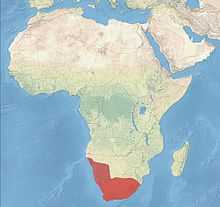Black harrier
| Black harrier | |
|---|---|
 | |
| Conservation status | |
| Scientific classification | |
| Kingdom: | Animalia |
| Phylum: | Chordata |
| Class: | Aves |
| Order: | Accipitriformes |
| Family: | Accipitridae |
| Genus: | Circus |
| Species: | C. maurus |
| Binomial name | |
| Circus maurus Temminck, 1828 | |
 | |
| The Distribution of the Black Harrier | |
The black harrier (Circus maurus) is a medium-sized (up to 46 cm long) African harrier of South Africa, Botswana, and Namibia.
When perched, this bird appears all black. However, in flight a white rump and flight feathers become visible. Its morphology is comparable to that of other harriers, with a slim body, narrow wings and a long tail. Male and female plumages are similar. Juveniles have buff under-parts and a heavily spotted breast.
Like other harriers it nests on the ground in tall vegetation. Three to five eggs are laid and incubated 35 days.
It feeds mostly on small rodents and birds and will occasionally take reptiles, catching them while flying low over its hunting grounds.
The greatest number of breeding pairs can be found in the Western Cape province, South Africa. In this area loose colonies aggregate around coastal wetlands. Breeding in Namibia is suspected but not confirmed.
The black harrier population has declined in recent years to less than 1000 birds and it is now classified as vulnerable, despite still having a wide breeding range. This is due to the destruction of its original breeding habitat, South Africa's natural shrubland, the fynbos, which has been greatly reduced by encroaching cereal culture and urban expansion.
References
- ↑ BirdLife International (2012). "Circus maurus". IUCN Red List of Threatened Species. Version 2013.2. International Union for Conservation of Nature. Retrieved 26 November 2013.
External links
- Black Harrier - Species text in The Atlas of Southern African Birds
- BirdLife Species Factsheet
- Black Harrier videos on the Internet Bird Collection
- Black Harrier at Raptors Namibia
- Black harrier photos at Fernkloof Nature Reserve
